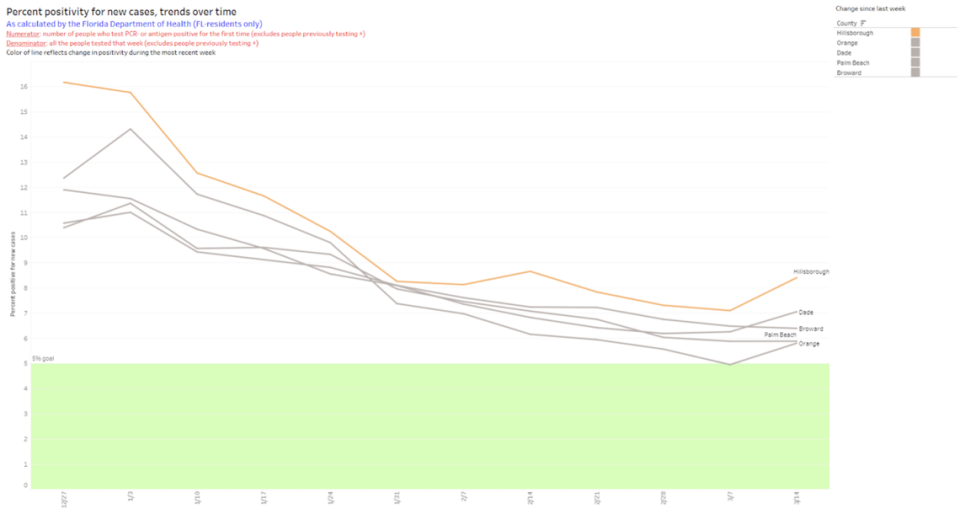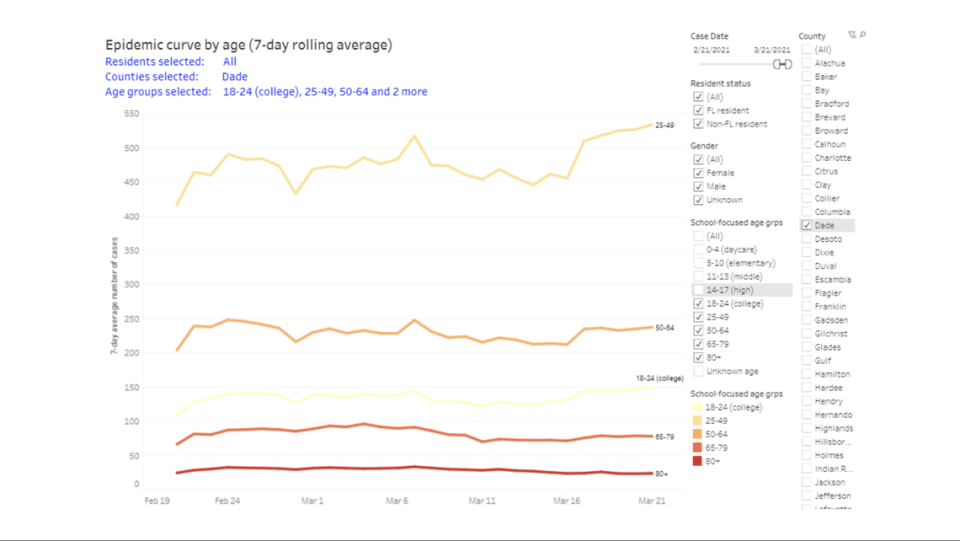Weeks into spring break, adults under 50 spur COVID rise in Florida tourism hubs
Florida’s pandemic month of March has been defined by the dueling dynamics of a mass vaccination effort focused on older people and a tourism surge to the metro areas of Miami, Tampa and Orlando, among other locales.
Those forces appear to have come to a head over the last week, with a rise in cases among people under 50 after months of decline, driving an uptick in the number of tests coming back positive and cementing transmission of the virus at a fairly high level, especially in Miami.
The trends played out in those three cities at the same time, and were present but not as exaggerated in other two populous South Florida counties that have a significant tourist base: Palm Beach and Broward. In older age groups, the most heavily vaccinated, cases have continued to decline.
The trends in Florida’s COVID cases point to the continued exposure and lack of vaccine protection in working people under the age of 50, who have fueled the state’s economy as Gov. Ron DeSantis has invited tourists from around the country to the state, even while more-contagious variants of the COVID virus spread widely.
Jason Salemi, an epidemiologist at the University of South Florida who has closely tracked the state’s COVID data, said that while the increases in cases and positivity aren’t yet at a level that is necessarily alarming, they merit watching closely and underscore a significant threat: that continued transmission among younger people could find pockets of medically vulnerable and older people who have not yet gotten a dose of a COVID vaccine.
More than 70% of the people over the age of 16 in Florida have not yet been vaccinated, and about 30% of those over the age of 65 haven’t received a vaccine either, Salemi noted. DeSantis restricted vaccine access primarily to people over the age of 65 until mid-March, and on Monday lowered it to 50.
“When we see increases like this, we know we have to pay attention,” Salemi said. “We know how hard it is to protect the vulnerable when there’s an increase in community transmission.”
The Florida Department of Health and DeSantis’ office did not respond to a request for comment Tuesday on the case trends in the three metro areas, and whether the governor had any plans to emphasize the vaccinations of essential workers in the tourism industry.

In the last week, Miami-Dade, Hillsborough, and Orange counties all saw a rise in the percentage of tests coming back positive, albeit a slight one, after several weeks of that metric declining, according to an analysis by Salemi shared with the Miami Herald. Those increases appear to be driven by two weeks of rising cases in people aged 25-49.
The percentage of tests coming back positive — also called positivity — is often one of the first metrics to rise when the virus starts spreading more quickly in a community.
Statewide, average daily COVID cases among people aged 25-49 have hovered around 2,000 per day, a little under half of the number of daily confirmed cases per day. In Miami-Dade, that number has jumped up from about 450 per day to 550 per day over the last week, similarly about half of the total caseload. By contrast, Broward County cases in that age bracket have remained flat at around 100 per day.
In Hillsborough, average daily cases in the 24-49 age bracket rose from about 120 to about 155 per day over the last two weeks, nearly half of the caseload. And in Orange County, that number has risen from about 110 to about 150 average cases per day in that time period.

Beach communities seeing uptick in cases
Eric Toner, a senior scholar at the Johns Hopkins Center for Health Security, took a broader look at Florida’s COVID data, concentrating on the difference between coastal tourism-driven counties and others. He concluded that the case trends are likely “related to tourism and activities in the beach communities.”
“Not so much being on the beach itself, but being in the bars and the restaurants and having parties, congregating in large numbers of people,” Toner said. “That’s a recipe for creating an epidemic, so I suspect that’s what we’re seeing.”
There hasn’t yet been a dramatic spike in COVID cases in South Florida.
Along with hospitalizations for severe COVID, case levels had come down from a high mid-January peak, but have begun to flatten out at a fairly high level over the last month, said Mary Jo Trepka, an epidemiologist at Florida International University, at least compared to the period of quiet last fall following a deadly summer surge.
Though hospitalizations have plateaued, about 550 to 600 patients are being treated for COVID-19 in Miami-Dade hospitals at any given time, according to state data, compared to about 250 patients at a time, which is where hospitalizations flattened out in October following the summer surge.
Dense crowds of spring break partygoers have lingered in Miami for weeks now, Trepka added, and that is likely just starting to affect the county’s simmering COVID numbers in the working-person age bracket.
“I can’t tell you what percentage is due to [more contagious] variants, relaxed mitigation, and spring break, but I wouldn’t be surprised if all of those are feeding into what is essentially our arrested drop in cases,” Trepka said.
Trepka said it is likely that vaccine protection — about 70% of Miami-Dade residents over the age of 65 have received at least one dose — has shielded the older age group from the worst effects of the stubborn levels of virus transmission in the community.
Toner, the Johns Hopkins scholar, said that cases continuing to decline in older age groups could also be driven by differences in behavior and work patterns.
“People over 50 probably work less in close contact with other people and probably engage less in some behaviors that are likely to promote spread, so it’s a little bit hard to know,” he said.
But Salemi, the University of South Florida epidemiologist who tracks COVID data, stressed that the virus has a way of finding vulnerable people anyway.
He said it would be helpful for health department officials to provide contact tracing data for some of the case increases and inform the public of where transmission is coming from.
“Without that data,” Salemi said, “[tourism] is certainly a good hypothesis for what we’re seeing.”

